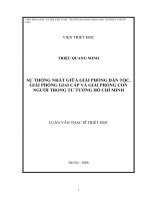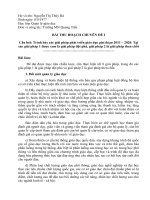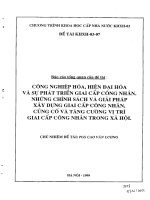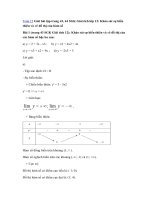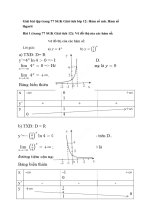20 câu ôn phần tiếng anh đánh giá năng lực đhqg tphcm phần 33 (bản word có giải)
Bạn đang xem bản rút gọn của tài liệu. Xem và tải ngay bản đầy đủ của tài liệu tại đây (138.88 KB, 13 trang )
20 câu ôn phần Tiếng Anh - Đánh giá năng lực ĐHQG TPHCM - Phần 33
(Bản word có giải)
1.2. TIẾNG ANH
Question 21 – 25: Choose a suitable word or phrase (marked A, B, C or D) to fill in each blank.
21. She ________ the piano when our guests _______ last night.
A. was playing/ arrived
B. played/ arrived
C. was playing/ were arriving
D. had played/arrived
22. _______she was very hard working, she hardly earned enough to feed her family.
A. In spite of
B. Because
C. Because of
D. Although
23. _____ me that she would never speak to me again, she picked up her stuff and stormed out of the
house.
A. To have told
B. Telling
C. Having told
D. Told
24. I can watch TV and play computer games on Sunday because I _____ go to school that day.
A. don’t have to
B. oughtn’t to
C. mustn’t
D. shouldn’t
25. Privacy seems to have _________ meaning for today’s children and even adults.
A. significantly
B. significance
C. significant
D. signification
Question 26 – 30: Each of the following sentences has one error (A, B, C or D). Find it and blacken your
choice on your answer sheet.
26. The assumption that smoking has bad effects on our health have been proved.
A
B
C
D
27. Fred Astaire is said to have been the most popular dancer of his time, but he was also a talented actor,
A
B
C
a singer, and choreographer.
D
28. Miranda still has trauma from the tragic accident, that took away her closest friend.
A
B
C
D
29. John, what is that noise? Is there something on the street?
A
B
C
D
30. The hotel has it’s own swimming pool but it doesn’t have warm water system in the winter.
A B
C
D
Question 31 – 35: Which of the following best restates each of the given sentences?
31. ''What are you going to do after school, Anne?'' Kevin asked.
A. Kevin asked Anne what was she going to do after school.
B. Kevin asked Anne what she was going to do after school.
C. Kevin wanted to know what Anne would do after school.
D. Kevin wanted to know what would Anne do after school.
32. Greater use of public transport would cut the amount of pollution from cars.
A. Were more people to use public transport, cars would stop releasing exhaust into the atmosphere.
B. If more people use public transport, it will cut the amount of pollution from cars.
C. If public transport was widely used, people would no longer suffer from pollution from cars.
D. If more people used public transport, there would be less pollution from cars.
33. If only you told me the truth about the theft.
A. You should have told me the truth about the theft.
B. I do wish you would tell me the truth about the theft.
C. You must have told me the truth about the theft.
D. It is necessary that you tell me the truth about the theft.
34. Timmy seems to be smarter than all the other kids in his group.
A. Timmy is as smart as all the kids in his group.
B. All the other kids in Timmy’s group are certainly not as smart as him.
C. Other kids are smart, but Timmy is smarter than most of them.
D. It is likely that Timmy is the smartest of all the kids in his group.
35. The newspaper reports that James was awarded the first prize.
A. The first prize is reported to award to James.
B. It is reported that James to be awarded the first prize.
C. It is reported that James wins the first prize.
D. James is reported to have been awarded the first prize.
Question 36 – 40: Read the passage carefully.
A letter of application is a sales letter in which you are both salesperson and product, for the purpose of
an application is to attract an employer's attention and persuade him or her to grant you an interview. To
do this, the letter presents what you can offer the employer, rather than what you want from the job.
Like a résumé, the letter of application is a sample of your work and an opportunity to demonstrate your
skills and personality. If it is written with flair and understanding and prepared with professional care, it
is likely to be very effective. While the résumé must be factual, objective, and brief, the letter is your
chance to interpret and expand. It should state explicitly how your background relates to the specific job,
and it should emphasise your strongest and most relevant characteristics. The letter should demonstrate
that you know both yourself and the company.
The letter of application must communicate your ambition and enthusiasm. Yet it must be modest. It
should be neither aggressive nor compliant: neither pat yourself on the back nor ask for sympathy. It
should never express dissatisfaction with the present or former job or employer. And you should avoid
discussing your reasons for leaving your last job.
Finally, it is best that you not broach the subject on salary. Indeed, even if a job advertisement requires
that you mention your salary requirements, it is advisable simply to call them "negotiable." However,
when you go on an interview, you should be prepared to mention a salary range. For this reason, you
should investigate both your field and, if possible, the particular company. You don't want to ask for less
than you deserve or more than is reasonable.
(Adapted from "Select Readings - Intermediate"by Linda Lee and Erik Gundersen)
Choose an option (A, B, C or D) that best answers each question.
36. What is the passage mainly about?
A. Advice on how to find a good job
B. Things to avoid during a job interview
C. Tips for writing an effective letter of application
D. Differences between a résumé and a letter of application
37. According to paragraph 1, in a letter of application, the applicant tries to ______.
A. persuade the employer to grant him/her an interview
B. get further information about the company
C. advertise a product to attract more customers
D. present what he/she wants from the job
38. The word "it" in paragraph 2 refers to ______.
A. the letter of application B. an opportunity
C. your work
D. the résumé
39. According to the passage, what can be inferred about a letter of application?
A. It should express the applicant's dissatisfaction with his/her former employer.
B. It should refer to the applicant's reasons for leaving his/her previous job.
C. It should be written very briefly, but in a formal style.
D. It should expand upon the information contained in the applicant's résumé.
40. The word "broach" in paragraph 4 is closest in meaning to ______.
A. avoid
B. investigate
C. introduce
D. understand
HƯỚNG DẪN GIẢI CHI TIẾT
1.2. TIẾNG ANH
Question 21 – 25: Choose a suitable word or phrase (marked A, B, C or D) to fill in each blank.
21. She ________ the piano when our guests _______ last night.
A. was playing/ arrived
B. played/ arrived
C. was playing/ were arriving
D. had played/arrived
Phương pháp giải:
Kiến thức: Sự phối hợp thì
Giải chi tiết:
Cách dùng: Thì quá khứ tiếp diễn diễn tả hành động đang xảy ra (chia q khứ tiếp diễn) vì có hành động
khác cắt ngang (chia quá khứ đơn).
Hành động “vị khách đến” làm ngắt quãng hành động “cô ấy chơi piano”.
Công thức: S + was/ were + V-ing when S + Ved/V2
Tạm dịch: Cơ ấy đang chơi pinao thì những vị khách bước vào.
Chọn A.
22. _______she was very hard working, she hardly earned enough to feed her family.
A. In spite of
B. Because
C. Because of
D. Although
Phương pháp giải:
Kiến thức: Mệnh đề nhượng bộ
Giải chi tiết:
In spite of + V_ing / N.phr. : Mặc dù
= Although + S + V
Because + S + V: bởi vì ….
= Because of + V_ing / N.phr.
Sau chỗ trống là “she was very hard working” là một cụm S + V => loại A, C
Tạm dịch: Mặc dù cô ấy rất chăm chỉ nhưng hiếm khi kiếm đủ tiền để ni gia đình.
Chọn D.
23. _____ me that she would never speak to me again, she picked up her stuff and stormed out of the
house.
A. To have told
B. Telling
C. Having told
D. Told
Phương pháp giải:
Kiến thức: Phân từ hoàn thành
Giải chi tiết:
Khi 2 mệnh đề trong câu có cùng chủ ngữ => có thể rút gọn mệnh đề
Hành động “tell” diễn ra trước hành động “picked up” trong QK nên sử dụng phân từ hoàn thành: having
+ P2
Tạm dịch: Sau khi nói rằng sẽ khơng bao giờ nói chuyện với tơi nữa, cơ ấy xách hành lí và đi ra khỏi
nhà.
Chọn C.
24. I can watch TV and play computer games on Sunday because I _____ go to school that day.
A. don’t have to
B. oughtn’t to
C. mustn’t
D. shouldn’t
Phương pháp giải:
Kiến thức: Động từ khuyết thiếu
Giải chi tiết:
not have to + V: khơng cần thiết phải làm gì đó
oughtn’t to + V_ngun thể: khơng nên làm gì
= shouldn’t + V_nguyên thể
mustn’t + V_nguyên thể: cấm làm gì
Tạm dịch: Tơi có thể xem TV và chơi game trên máy tính vào ngày Chủ nhật vì tơi khơng phải đi học
vào hơm đó.
Chọn A.
25. Privacy seems to have _________ meaning for today’s children and even adults.
A. significantly
B. significance
C. significant
D. signification
Phương pháp giải:
Kiến thức: Từ loại
Giải chi tiết:
Cần một tính từ đứng trước để bổ nghĩa cho danh từ "meaning" (ý nghĩa)
significantly (adv): đáng kể
significance (n): ý nghĩa, sự quan trọng, sự đáng kể
significant (adj): có ý nghĩa, quan trọng, đáng kể
signification (n): ý nghĩa (của một từ); sự biểu thị
Tạm dịch: Quyền riêng tư dường như có ý nghĩa quan trọng cho trẻ em ngày nay và thậm chí cả người
lớn.
Chọn C.
Question 26 – 30: Each of the following sentences has one error (A, B, C or D). Find it and blacken your
choice on your answer sheet.
26. The assumption that smoking has bad effects on our health have been proved.
A
B
C
D
Phương pháp giải:
Kiến thức: Sự hòa hợp giữa chủ ngữ và động từ
Giải chi tiết:
Chủ ngữ chính của câu là assumption (giả định) - là danh từ không đếm được => động từ theo sau chia số
ít.
Sửa: have been proved => has been proved
Tạm dịch: Giả định rằng hút thuốc có ảnh hưởng xấu đến sức khỏe của chúng ta đã được chứng minh.
Chọn D.
27. Fred Astaire is said to have been the most popular dancer of his time, but he was also a talented actor,
A
B
C
a singer, and choreographer.
D
Phương pháp giải:
Kiến thức: Mạo từ
Giải chi tiết:
Khi các danh từ liên tiếp được liệt kê để bổ nghĩa cho một người/ vật thì chỉ dùng mạo từ một lần cho
danh từ đầu tiên.
Sửa: a singer => singer
Tạm dịch: Fred Astaire được coi là vũ công nổi tiếng nhất thời bấy giờ, nhưng anh còn là một diễn viên,
ca sĩ và biên đạo múa tài năng nữa.
Chọn D.
28. Miranda still has trauma from the tragic accident, that took away her closest friend.
A
B
C
D
Phương pháp giải:
Kiến thức: Đại từ quan hệ
Giải chi tiết:
Dùng đại từ quan hệ “which” để thay thế cho cả vế câu phía trước, trước nó có dấu phẩy.
Đại từ quan hệ “that” không đứng sau dấu phẩy.
Sửa: that => which
Tạm dịch: Miranda vẫn bị khủng hoảng từ vụ tai nạn bi thảm này, cái mà đã lấy đi người bạn thân nhất
của cô.
Chọn C.
29. John, what is that noise? Is there something on the street?
A
B
C
D
Phương pháp giải:
Kiến thức: Đại từ bất định
Giải chi tiết:
something: một vài thứ gì đó => khơng dùng trong câu nghi vấn (trừ những câu mang tính chất mời, gợi
ý)
anything: bất kì thứ gì => dùng trong câu phủ định & nghi vấn
Sửa: something => anything
Tạm dịch: John ơi, tiếng động đó là gì vậy? Có thứ gì ở ngồi đường phố à?
Chọn C.
30. The hotel has it’s own swimming pool but it doesn’t have warm water system in the winter.
A B
C
D
Phương pháp giải:
Kiến thức: Tính từ sở hữu
Giải chi tiết:
it’s = it is
its: của nó (chỉ sở hữu cho danh từ số ít)
Sửa: it’s => its
Tạm dịch: Khách sạn có hồ bơi riêng của nó nhưng hồ bơi khơng có hệ thống nước nóng vào mùa đơng.
Chọn A.
Question 31 – 35: Which of the following best restates each of the given sentences?
31. ''What are you going to do after school, Anne?'' Kevin asked.
A. Kevin asked Anne what was she going to do after school.
B. Kevin asked Anne what she was going to do after school.
C. Kevin wanted to know what Anne would do after school.
D. Kevin wanted to know what would Anne do after school.
Phương pháp giải:
Kiến thức: Tường thuật câu hỏi
Giải chi tiết:
Cấu trúc câu tường thuật của Wh-question: S + asked + O + wh-words + S + V (lùi thì).
you => she
are => was
Tạm dịch: Kevin hỏi: “ Sau giờ học bạn định làm gì, Anne?”
A. Sai cấu trúc: was she => she was
B. Kevin hỏi Anne cô ấy dự định làm gì sau giờ học.
C. Sai cấu trúc: would do => was going to do
D. Sai cấu trúc: would Anne do => Anne was going to do
Chọn B.
32. Greater use of public transport would cut the amount of pollution from cars.
A. Were more people to use public transport, cars would stop releasing exhaust into the atmosphere.
B. If more people use public transport, it will cut the amount of pollution from cars.
C. If public transport was widely used, people would no longer suffer from pollution from cars.
D. If more people used public transport, there would be less pollution from cars.
Phương pháp giải:
Kiến thức: Câu điều kiện loại 2
Giải chi tiết:
Cách dùng: Câu điều kiện loại 2 diễn tả một giả thiết, điều kiện trái hiện tại, dẫn đến kết quả trái với hiện
tại.
Cấu trúc: If + S + Ved/V2, S + would/could + V.
Tạm dịch: Sử dụng nhiều phương tiện giao thông công cộng hơn sẽ làm giảm ô nhiễm gây ra bởi ô tô cá
nhân.
A. Nếu nhiều người sử dụng phương tiện giao thông công cộng hơn, ô tơ cá nhân sẽ ngừng thải khí thải ra
khơng khí. => sai về nghĩa
B. Sai cấu trúc: use => used; will => would
C. Nếu các phương tiện giao thông công cộng được sử dụng rộng rãi, con người sẽ không phải chịu ô
nhiễm do ô tô cá nhân nữa. => sai về nghĩa
D. Nếu nhiều người sử dụng phương tiện giao thơng cơng cộng, sẽ có ít ơ nhiễm gây ra bởi ô tô cá nhân
hơn.
Chọn D.
33. If only you told me the truth about the theft.
A. You should have told me the truth about the theft.
B. I do wish you would tell me the truth about the theft.
C. You must have told me the truth about the theft.
D. It is necessary that you tell me the truth about the theft.
Phương pháp giải:
Kiến thức: Động từ khuyết thiếu, câu ước
Giải chi tiết:
Cấu trúc câu ước: If only + S + Ved/V2 + …: ước gì, giá mà
Cấu trúc câu phỏng đoán:
should + have + P2: lẽ ra đã nên làm gì trong q khứ (nhưng đã khơng làm)
must + have + V.p.p: chắc hẳn đã làm gì trong quá khứ
Tạm dịch: Ước gì bạn nói với mình sự thật về kẻ trộm.
A. Bạn lẽ ra đã nên nói cho mình sự thật về kẻ trộm.
B. S + wish (es) + S + would + Vo: Mong ước ở tương lai => sai về thi
C. Bạn chắc hẳn đã nói với mình sự thật về kẻ trộm. => sai về nghĩa
D. Bạn cần thiết phải nói với mình sự thật về kẻ trộm. => sai về nghĩa, sai thì
Chọn A.
34. Timmy seems to be smarter than all the other kids in his group.
A. Timmy is as smart as all the kids in his group.
B. All the other kids in Timmy’s group are certainly not as smart as him.
C. Other kids are smart, but Timmy is smarter than most of them.
D. It is likely that Timmy is the smartest of all the kids in his group.
Phương pháp giải:
Kiến thức: So sánh nhất
Giải chi tiết:
seems to be + adj = be likely: có vẻ như, dường như
certainly: chắc chắn
Tạm dịch: Timmy có vẻ là thơng minh hơn tất cả những đứa trẻ cịn lại trong nhóm.
A. Timmy thơng minh như tất cả những đứa trẻ trong nhóm của cậu bé. => sai nghĩa
B. Tất cả những đứa trẻ khác trong nhóm Timmy chắc chắn khơng thơng minh bằng cậu bé. => sai nghĩa
C. Những đứa trẻ khác thông minh, nhưng Timmy thông minh hơn hầu hết chúng. => sai nghĩa
D. Dường như Timmy là người thông minh nhất trong tất cả những đứa trẻ trong nhóm của cậu bé.
Chọn D.
35. The newspaper reports that James was awarded the first prize.
A. The first prize is reported to award to James.
B. It is reported that James to be awarded the first prize.
C. It is reported that James wins the first prize.
D. James is reported to have been awarded the first prize.
Phương pháp giải:
Kiến thức: Câu bị động đặc biệt
Giải chi tiết:
Câu tường thuật dạng bị động sử dụng theo cấu trúc:
Câu chủ động: S1 + V1 (that) + S2 + V2 +....
V1 (reports) chia thì hiện tại đơn, V2 (was awarded) chia thì quá khứ đơn, dạng bị động
Câu bị động: S2 + be + V1 p.p + to have + been + V_PP ....
Tạm dịch: Tờ báo cho biết James đã được trao giải nhất.
= James được cho là đã được trao giải nhất.
Chọn D.
Question 36 – 40: Read the passage carefully.
A letter of application is a sales letter in which you are both salesperson and product, for the purpose of
an application is to attract an employer's attention and persuade him or her to grant you an interview. To
do this, the letter presents what you can offer the employer, rather than what you want from the job.
Like a résumé, the letter of application is a sample of your work and an opportunity to demonstrate your
skills and personality. If it is written with flair and understanding and prepared with professional care, it
is likely to be very effective. While the résumé must be factual, objective, and brief, the letter is your
chance to interpret and expand. It should state explicitly how your background relates to the specific job,
and it should emphasise your strongest and most relevant characteristics. The letter should demonstrate
that you know both yourself and the company. (Đề thi này được phát hành trên website Tailieuchuan.vn)
The letter of application must communicate your ambition and enthusiasm. Yet it must be modest. It
should be neither aggressive nor compliant: neither pat yourself on the back nor ask for sympathy. It
should never express dissatisfaction with the present or former job or employer. And you should avoid
discussing your reasons for leaving your last job.
Finally, it is best that you not broach the subject on salary. Indeed, even if a job advertisement requires
that you mention your salary requirements, it is advisable simply to call them "negotiable." However,
when you go on an interview, you should be prepared to mention a salary range. For this reason, you
should investigate both your field and, if possible, the particular company. You don't want to ask for less
than you deserve or more than is reasonable.
(Adapted from "Select Readings - Intermediate"by Linda Lee and Erik Gundersen)
Choose an option (A, B, C or D) that best answers each question.
36. What is the passage mainly about?
A. Advice on how to find a good job
B. Things to avoid during a job interview
C. Tips for writing an effective letter of application
D. Differences between a résumé and a letter of application
Phương pháp giải:
Kiến thức: Đọc tìm ý chính
Giải chi tiết:
Đoạn văn chủ yếu nói về cái gì?
A. Lời khun về cách tìm một cơng việc tốt
B. Những điều cần tránh trong một cuộc phỏng vấn xin việc
C. Bí kíp để viết một lá thư xin việc hiệu quả
D. Sự khác biệt giữa một bản sơ yếu lý lịch và một lá thư xin việc
Thông tin: A letter of application is a sales letter in which you are both salesperson and product, for the
purpose of an application is to attract an employer's attention and persuade him or her to grant you an
interview. To do this, the letter presents what you can offer the employer, rather than what you want from
the job.
Tạm dịch: Thư xin việc là một bức thư bán hàng trong đó bạn là vừa là nhân viên bán hàng vừa là sản
phẩm, với mục đích thu hút sự chú ý của một nhà tuyển dụng và thuyết phục họ cho bạn cuộc phỏng vấn.
Để làm điều này, lá thư trình bày những gì bạn có thể cung cấp cho nhà tuyển dụng, thay vì những gì bạn
muốn từ công việc.
Chọn C.
37. According to paragraph 1, in a letter of application, the applicant tries to ______.
A. persuade the employer to grant him/her an interview
B. get further information about the company
C. advertise a product to attract more customers
D. present what he/she wants from the job
Phương pháp giải:
Kiến thức: Đọc tìm chi tiết
Giải chi tiết:
Theo đoạn 1, trong một lá thư xin việc, người nộp đơn cố gắng ______.
A. thuyết phục người tuyển dụng cho họ một cuộc phỏng vấn
B. nhận thêm thông tin về công ty
C. quảng cáo sản phẩm để thu hút nhiều khách hàng hơn
D. trình bày những gì anh/cơ ấy muốn từ công việc
Thông tin: A letter of application is a sales letter in which you are both salesperson and product, for the
purpose of an application is to attract an employer's attention and persuade him or her to grant you an
interview.
Tạm dịch: Thư xin việc là một bức thư bán hàng trong đó bạn là vừa là nhân viên bán hàng vừa là sản
phẩm, với mục đích thu hút sự chú ý của một nhà tuyển dụng và thuyết phục họ cho bạn cuộc phỏng vấn.
Chọn A.
38. The word "it" in paragraph 2 refers to ______.
A. the letter of application B. an opportunity
C. your work
D. the résumé
Phương pháp giải:
Kiến thức: Đại từ thay thế
Giải chi tiết:
Từ "it" trong đoạn 2 đề cập đến ______.
A. thư xin việc
B. một cơ hội
C. công việc của bạn
D. bản lý lịch
Thông tin: Like a résumé, the letter of application is a sample of your work and an opportunity to
demonstrate your skills and personality. If it is written with flair and understanding and prepared with
professional care, it is likely to be very effective.
Tạm dịch: Giống như một lý lịch, thư xin việc là một mẫu của công việc của bạn và một cơ hội để chứng
minh kỹ năng và tính cách của bạn. Nếu thư xin việc được viết với sự tinh tế và sự hiểu biết và được
chuẩn bị với sự cẩn trọng chuyên nghiệp, nó có thể sẽ rất hiệu quả.
Chọn A.
39. According to the passage, what can be inferred about a letter of application?
A. It should express the applicant's dissatisfaction with his/her former employer.
B. It should refer to the applicant's reasons for leaving his/her previous job.
C. It should be written very briefly, but in a formal style.
D. It should expand upon the information contained in the applicant's résumé.
Phương pháp giải:
Kiến thức: Suy luận
Giải chi tiết:
Theo đoạn văn, điều nào có thể được suy ra về một lá thư xin việc?
A. Nó nên thể hiện sự khơng hài lịng của người nộp đơn đối với người chủ cũ của mình.
B. Nó nên đề cập đến lý do của người nộp đơn nghỉ công việc trước đây của mình.
C. Nó nên được viết rất ngắn gọn, nhưng theo một phong cách trang trọng.
D. Nó sẽ mở rộng dựa trên thông tin nêu trong lý lịch của người nộp đơn.
Thông tin: While the résumé must be factual, objective, and brief, the letter is your chance to interpret
and expand.
Tạm dịch: Trong khi lý lịch phải chính xác, khách quan và ngắn gọn, lá thư là cơ hội của bạn để giải
thích và mở rộng.
Chọn D.
40. The word "broach" in paragraph 4 is closest in meaning to ______.
A. avoid
B. investigate
C. introduce
D. understand
Phương pháp giải:
Giải chi tiết:
Kiến thức: Từ vựng
Giải thích:
Từ "broach" trọng đoạn 4 gần nghĩa nhất với _______.
broach (v): bắt đầu, đề cập đến vấn đề gì
A. avoid (v): tránh
B. investigate (v): điều tra
C. introduce (v): giới thiệu, bắt đầu
D. understand (v): hiểu
=> introduce = broach
Thông tin: Finally, it is best that you not broach the subject on salary.
Tạm dịch: Cuối cùng, tốt nhất là bạn không đề cập đến chủ đề về tiền lương.
Chọn C.
Chú ý khi giải:
Dịch bài đọc:
Thư xin việc là một bức thư bán hàng trong đó bạn là vừa là nhân viên bán hàng vừa là sản phẩm,
với mục đích thu hút sự chú ý của một nhà tuyển dụng và thuyết phục họ cho bạn cuộc phỏng vấn. Để
làm điều này, lá thư trình bày những gì bạn có thể cung cấp cho nhà tuyển dụng, thay vì những gì bạn
muốn từ công việc.
Giống như một lý lịch, thư xin việc là một mẫu của công việc của bạn và một cơ hội để chứng
minh kỹ năng và tính cách của bạn. Nếu nó được viết với sự tinh tế và sự hiểu biết và được chuẩn bị với
sự cẩn trọng chuyên nghiệp, nó có thể sẽ rất hiệu quả. Trong khi lý lịch phải chính xác, khách quan và
ngắn gọn, lá thư là cơ hội của bạn để giải thích và mở rộng. Cần nêu rõ việc nền tảng của bạn phục vụ cho
cơng việc đó như thế nào, và cần nhấn mạnh điểm mạnh nhất và phù hợp nhất của bạn. Bức thư nên
chứng minh rằng bạn hiểu cả bản thân mình lẫn công ty.
Thư xin việc phải truyền đạt khát khao và sự nhiệt tình của bạn. Tuy nhiên, nó phải khiêm tốn. Nó
khơng nên q hung hăng cũng khơng nên q nhún nhường: không thổi phồng bản thân và cũng không
yêu cầu sự thơng cảm. Nó khơng bao giờ nên thể hiện sự khơng hài lịng với cơng việc, người chủ hiện tại
hoặc trước đây. Và bạn nên tránh thảo luận về lý do bạn nghỉ làm công việc cuối cùng.
Cuối cùng, tốt nhất là bạn không đề cập đến chủ đề về tiền lương. Thật vậy, ngay cả khi một
quảng cáo việc làm đòi hỏi bạn phải đề cập đến các yêu cầu về lương, bạn nên để là "có thể thương
lượng". Tuy nhiên, khi bạn đi phỏng vấn, bạn nên chuẩn bị đề cập đến một mức lương. Vì lý do này, bạn
nên tìm hiểu cả lĩnh vực của mình và, nếu có thể, cả cơng ty nữa. Bạn khơng muốn địi hỏi ít hơn mức
lương bạn xứng đáng được hưởng hoặc nhiều hơn mức lương hợp lý.
(Phỏng theo “Select Readings - Intermediate” của Linda Lee và Erik Gundersen)
